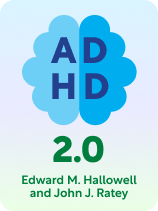

This article is an excerpt from the Shortform book guide to "ADHD 2.0" by John Ratey and Edward Hallowell. Shortform has the world's best summaries and analyses of books you should be reading.
Like this article? Sign up for a free trial here.
Does your mind seem to wander constantly? Do you often feel distracted, tired, or bored—or do you know someone who does?
Attention Deficit Hyperactivity Disorder (ADHD) is a neurological condition that’s estimated to occur in 5% to 10% of the world’s population. Psychiatrists Edward Hallowell and John Ratey describe three common signs of ADHD that might prompt you to seek a professional diagnosis.
Read more to learn about these signs and understand how to put them into context.
Common Signs of ADHD
You might wonder whether you or someone you know has ADHD. The most obvious signs of it are an inability to concentrate, a lack of motivation, and trouble sitting still without squirming or fidgeting. While Hallowell and Ratey point out that only a mental health professional can diagnose such conditions, they describe additional common signs of ADHD that can help you know whether it’s likely that you or someone you know has the condition.
1) Racing, uncontrollable thoughts. People with ADHD have extremely quick minds, coupled with difficulty controlling or directing their thoughts. In other words, their thoughts move much faster than other people’s, but not always in useful ways—they often get stuck in cycles of uncomfortable, anxious, or brooding thoughts.
(Shortform note: A racing mind isn’t unique to ADHD—it’s a feature of many conditions, and even neurotypical people sometimes find themselves overwhelmed by rapid, relentless thoughts. Practices to break out of racing thoughts include grounding techniques (deliberately observing and thinking about your present circumstances), a quick bout of intense exercise, and deep breathing exercises.)
2) Underachievement. People with ADHD frequently fall short of what others expect them to achieve. Parents, teachers, and bosses often mistakenly blame such underachievement on a lack of effort or interest. For example, a smart student who consistently underperforms in certain subjects may be struggling with undiagnosed ADHD.
(Shortform note: Often, this underachievement is the result of being “2E”: “twice exceptional.” 2E refers to someone who’s highly intelligent but also has a psychological disorder such as ADHD or autism. Notably, a 2E person’s giftedness often masks their disorder, especially during childhood—they’re smart enough to get through school in spite of their unique difficulties, though they don’t do as well as they could have done. This may explain why, instead of getting the diagnosis and support they need, 2E people (of any age) are often simply accused of laziness or apathy and shamed for not living up to their potential.)
3) General dissatisfaction. People with ADHD often feel that normal, everyday life isn’t “enough”—exciting enough, interesting enough, fulfilling enough, and so on. As a result, they look for ways to enhance or intensify their lives. Sometimes this results in incredible achievements, but it may also result in addiction or dangerous, thrill-seeking behavior.
(Shortform note: ADHD is characterized by chronic boredom and difficulty fitting in with peers, which helps explain why it so frequently leads to dissatisfaction with life. In fact, the authors may be understating how serious this dissatisfaction is: Untreated ADHD can lead to clinical depression.)

———End of Preview———
Like what you just read? Read the rest of the world's best book summary and analysis of John Ratey and Edward Hallowell's "ADHD 2.0" at Shortform.
Here's what you'll find in our full ADHD 2.0 summary:
- How people can thrive because of—not in spite of—having ADHD
- The biological causes of ADHD and its most prominent symptoms
- Ways to minimize ADHD's downsides and maximize the benefits






